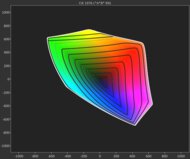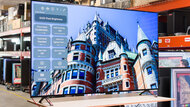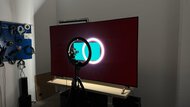PC monitors and TVs are close relatives. TVs usually have more advanced image processing capabilities than monitors, come equipped with tuners, and are usually bigger, which you can read more about in our PC monitor vs TV article. When evaluating how good a TV is for PC monitor use, there are certain criteria to consider. Input lag and response time are other essential components of a good monitor TV. Input lag is the time it takes for a frame sent by a source (like a PC) to display on the screen. A low input lag makes the entire experience more responsive, as your inputs on a controller or mouse are reflected more quickly onscreen. Response time is the time it takes for a pixel to change from one color to the next, which affects how much blur you see behind fast motion.
A good viewing angle is important when using a TV as a monitor, as you might be sitting very close to what is otherwise a huge screen. If the TV's viewing angle is inadequate, sitting so close to it will lead to noticeable image degradation at the sides of your peripheral vision; thus, the center of the screen might look brighter than the sides, and similarly, the center might be brighter than the top or bottom. If you use your PC in a bright room and actually want to see what's on the screen, you also need a display that's bright enough and has the reflection handling needed to fight glare.
This article mostly focuses on the gaming performance of TVs available in the 42-inch to 48-inch size range, as most people will find anything larger than that too big for monitor usage. Through our rigorous testing procedure, we're able to determine what TVs fit this criteria, and below are our recommendations for the best TVs to use as a PC monitor. Check out our picks for the best gaming TVs if you want a larger TV to pair with your PC rig. Also, see our picks for the best TVs and the best LED TVs if you're concerned about all-around performance. If you're still considering a traditional monitor, take a look at the best monitors. You can also vote on which TVs you want us to buy and test. To learn more about the 2025 TV releases, check out our 2025 TV lineup page.

We buy and test dozens of TVs yearly, taking an objective, data-driven approach to deliver results you can trust. Our testing process is complex, with hundreds of individual tests that take over a week to complete. Most of our tests are done with specially designed test patterns that mimic real content, but we also use the same sources you have at home to ensure our results match the real-world experience. We use two main tools for our testing: a Colorimetry Research CR-100 colorimeter and a CR-250 spectroradiometer.
-
Best TV Monitor
 Gaming8.8Bright Room7.7Game Mode Responsiveness9.3Brightness8.3Black Level10Color8.3Resolution:4kNative Refresh Rate:144HzScreen Finish:GlossyType:OLEDSub-Type:WOLEDDolby Vision:YesSee all our test resultsSizes:42" 48" 55" 65" 77" 83"
Gaming8.8Bright Room7.7Game Mode Responsiveness9.3Brightness8.3Black Level10Color8.3Resolution:4kNative Refresh Rate:144HzScreen Finish:GlossyType:OLEDSub-Type:WOLEDDolby Vision:YesSee all our test resultsSizes:42" 48" 55" 65" 77" 83"The best TV for PC monitor usage is the LG C5 OLED, which is one of the few higher-end TVs on the market available in a 42-inch model. It offers a solid combination of gaming features and picture quality, making it great for PC gamers. The TV has four HDMI 2.1 ports, offers up to 4k @ 144Hz, and is compatible with HDMI Forum VRR, FreeSync, and G-SYNC. Furthermore, it has the nearly instantaneous pixel response times that OLEDs are known for, leading to crisp motion. Gaming feels responsive thanks to its very low input lag, so you're not at a disadvantage when playing competitive titles. Chroma 4:4:4 signals are displayed properly, which helps with text clarity. However, text still isn't perfectly clear due to the TV's RWBG subpixel layout, so it's not a great choice if you're doing text-critical work on a daily basis.
The TV's picture quality is very impressive, with inky blacks, vibrant colors, and enough brightness to make highlights truly stand out in HDR games and other content. The TV does a great job overcoming glare from indirect light sources, like overhead lights. However, it struggles a bit with reducing the intensity of direct reflections, which isn't ideal if you have a lamp behind you that's directly facing the screen. Fortunately, blacks stay very deep, and colors stay vibrant in a bright room, so you don't have to trade in very much image quality when you have your lights on, like you do on QD-OLED displays. Unfortunately, you might notice diagonal lines in darker scenes that are a result of dithering. Not everyone will notice these, but the closer you sit, the greater the chance there is that you will see them, so keep that in mind before you make your purchase.
-
Best Mini LED Monitor TV
 Gaming7.8Bright Room8.7Game Mode Responsiveness7.8Brightness9.0Black Level8.3Color7.7Resolution:4kNative Refresh Rate:165HzScreen Finish:MatteType:LEDSub-Type:VADolby Vision:NoSee all our test resultsSizes:43" 50" 55" 65" 75" 85" 98"
Gaming7.8Bright Room8.7Game Mode Responsiveness7.8Brightness9.0Black Level8.3Color7.7Resolution:4kNative Refresh Rate:165HzScreen Finish:MatteType:LEDSub-Type:VADolby Vision:NoSee all our test resultsSizes:43" 50" 55" 65" 75" 85" 98"The Samsung QN90F is the best Mini LED TV to buy for PC monitor usage if you simply don't want an OLED, or you typically use your display in a very bright room. It comes in a 43-inch model and has most of the same gaming features as the LG C5 OLED, so you still get HDMI 2.1 bandwidth, support for all three major VRR formats, and similarly low input lag. It even supports up to 4k @ 165Hz, so you can push your frame rate a bit more than you can on the C5. The biggest difference here is that pixel response times are slower than they are on OLEDs, so you do see blur behind fast motion. Chroma 4:4:4 signals are supported, but since the TV uses a BGR subpixel layout, text isn't perfectly clear.
The TV doesn't display the same perfect blacks as an OLED, but it does offer solid local dimming, so blacks are deep and bold. However, there is haloing around highlights in dark scenes. Fortunately, this is a colorful TV, so HDR games are nice and vibrant. The TV's biggest advantages are its brightness and matte screen coating. This combination essentially eliminates reflections from both indirect and direct light sources in a very bright room, so it's a great choice if you have lamps or windows directly behind you. Unfortunately, the TV blacks levels are raised in a bright room, and colors lose perceived saturation, so it doesn't look as good in a well-lit room as it does in a dark room.
-
Best Mid-Range Monitor TV
 Gaming8.5Bright Room6.7Game Mode Responsiveness9.0Brightness7.0Black Level10Color8.3Resolution:4kNative Refresh Rate:120HzScreen Finish:GlossyType:OLEDSub-Type:WOLEDDolby Vision:YesSee all our test resultsSizes:48" 55" 65" 77" 83"
Gaming8.5Bright Room6.7Game Mode Responsiveness9.0Brightness7.0Black Level10Color8.3Resolution:4kNative Refresh Rate:120HzScreen Finish:GlossyType:OLEDSub-Type:WOLEDDolby Vision:YesSee all our test resultsSizes:48" 55" 65" 77" 83"The best TV to use as a monitor in the mid-range category is the LG B5 OLED. It isn't available in a 42-inch size like the LG C5 OLED is, but if you're okay with a 48-inch model, it's a great choice. It doesn't support 144Hz or 165Hz, but it still has four HDMI 2.1 ports capable of 4k @ 120Hz. It supports FreeSync, HDMI Forum VRR, and G-SYNC, so it delivers nearly tear-free gaming with all modern GPUs. Pixel response times are nearly instantaneous, so fast motion is nice and clear. The TV's input lag is also very low, especially at 120Hz, so it delivers a snappy experience whether you're gaming or doing other tasks. Chroma 4:4:4 signals are displayed properly, which is essential for good text clarity, but since the TV doesn't use a traditional RGB subpixel layout, text isn't as clear as it could be.
It has the same perfect black levels as the C5, and colors are similarly vibrant, so image quality is still excellent. The biggest trade-off you have to make by going with this model over the C5 is brightness, but it's still bright enough in HDR for an impactful HDR gaming experience. It's more limited in SDR brightness, so it doesn't completely overcome glare in a bright room, but it's still bright enough for moderately lit rooms. Like the C5, image quality doesn't take a big hit when you have your lights on, which is great. One of the biggest advantages of this model over the C5 is that there are no diagonal lines in darker scenes, making it a great option for those who want a big OLED to use as a monitor but are worried about those lines.
Notable Mentions
-
Samsung QN42S90FAEXZA:
The 42-inch Samsung S90F OLED is an alternative to the LG C5 OLED and has most of the same features. Unfortunately, the 42-inch model uses a WOLED panel instead of the QD-OLED panel found on the larger sizes, so it doesn't have the increased color vibrancy. Therefore, the C5 is better since it supports Dolby Vision, is brighter, and has better image processing.
See our review
Recent Updates
Oct 23, 2025:
We revamped the article to specifically focus on TVs available in 42-48" sizes, since anything larger than that is typically too big to use as a monitor. The LG C5 OLED is now our top pick instead of the Samsung S95F OLED, the LG B5 OLED retains its spot as the 'Best Mid-Range' option, and the Samsung QN90F has been added as the 'Best Mini LED' pick. The TCL QM7K and the TCL QM6K have been dropped from the article, since they're only available in larger sizes. Finally, we refreshed the Notable Mentions section.
Sep 05, 2025:
We dropped the 'Best Monitor TV For PC Gaming' section since we reworked the article to mostly focus on gaming performance. Our new top pick, the Samsung S95F OLED, technically replaced the Samsung S90D OLED. We also replaced the Hisense U8N with the LG B5 OLED, the Hisense U7N with the TCL QM7K, and the TCL Q651G with the TCL QM6K. Furthermore, we dropped the 'Best Cheap Monitor TV' section since no cheap TV on the market is really suitable for use as a PC monitor. Finally, we updated the Notable Mentions section and updated some other text throughout the article for clarity.
Feb 20, 2025:
Added a link to our 2025 TV Lineup article and refreshed some text throughout for accuracy.
Nov 26, 2024:
We replaced the Samsung QN85D QLED with the Hisense U8/U8N in the 'Best Mid-Range Monitor TV' category and replaced the Roku Select Series with the Hisense A7N in the 'Best Cheap Monitor TV' category. We also refreshed the Introduction section for clarity.
Aug 30, 2024: Replaced the Samsung QN90C/QN90CD QLED, the Samsung S90C OLED, the Samsung QN85C/QN85CD QLED, the Hisense U7K, and the TCL Q5/Q550G QLED with their 2024 successors.
All Reviews
Our recommendations above are what we think is currently the best TV to use as a monitor for most people in each price range. We factor in the price (a cheaper TV wins over a pricier one if the difference isn't worth it), feedback from our visitors, and availability (no TVs that are difficult to find or almost out of stock everywhere).
If you would like to do the work of choosing yourself, here is the list of all our TV reviews. Be careful not to get too caught up in the details. While no TV is perfect, most TVs are great enough to please almost everyone, and the differences are often not noticeable unless you really look for them. Also, keep in mind that our scores aren't comparable across different test benches, so most of the TVs in the list below score higher than they would in 2025.












